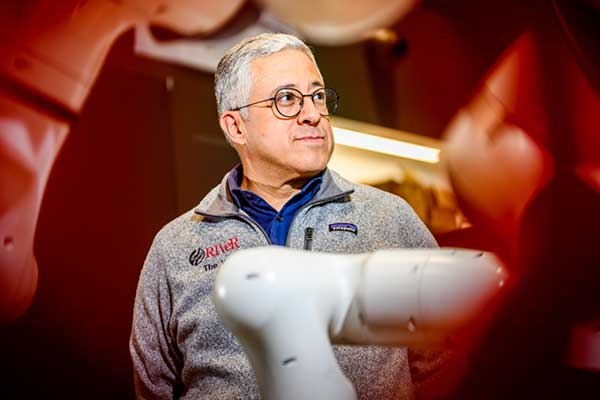Autonomous Wheelchair Project Positively Impacts Individuals

ECE Professor Taskin Padir talks about an AI-powered autonomous wheelchair that could be an impactful technological advancement for individuals with quadriplegia and other physical conditions.
This article originally appeared on Northeastern Global News. It was published by Cesareo Contreras. Main photo: Taskin Padir, a professor of electrical and computer engineering, is the director of Northeastern’s Robotics and Intelligent Vehicle Research Laboratory. Photo by Matthew Modoono/Northeastern University.
This AI-powered autonomous wheelchair will deliver a new level of independence
They weigh more than 400 lbs., are often powered by lead-acid batteries and much of their software is locked behind complicated licensing agreements.
While there have been advancements in the assistive technology space with innovations in computer vision, soft robotics and other AI technologies, motorized wheelchairs are still stuck in the past, says Northeastern graduate Todd Roberts, CEO of Assistive Technology Development Inc., which develops rehabilitation devices.
“What patients can get access to on the market is really stuck in the ’90s,” he says.
Researchers out of Northeastern University’s Robotics and Intelligent Vehicle Research Laboratory are helping Roberts change that in a major way – they are partnering with the company to develop a new autonomous wheelchair system featuring a robotic arm.
Researchers say the system could enable a new level of independence for people with quadriplegia and other physical conditions that limit mobility.
“This is a big steroid shot to make a difference in the lives of those individuals,” says Taskin Padir, a Northeastern professor of electrical and computer engineering and the director for the RIVeR lab.
The autonomous wheelchair project is part of the Robotic Assistive Mobility and Manipulation Platform Providing Independence for People with Disabilities project, or RAMMP, a multi-university and private business collaboration funded primarily by the Department of Health and Human Services’ Advanced Research Projects Agency for Health, or ARPA-H, with a total of up to $41 million.
While we are still far away from using robotics for “more complex tasks” like assisting individuals in getting out of bed or dressing themselves, today’s state-of- the art technology could still enable a new level of autonomy, Roberts says.
Read full story at Northeastern Global News